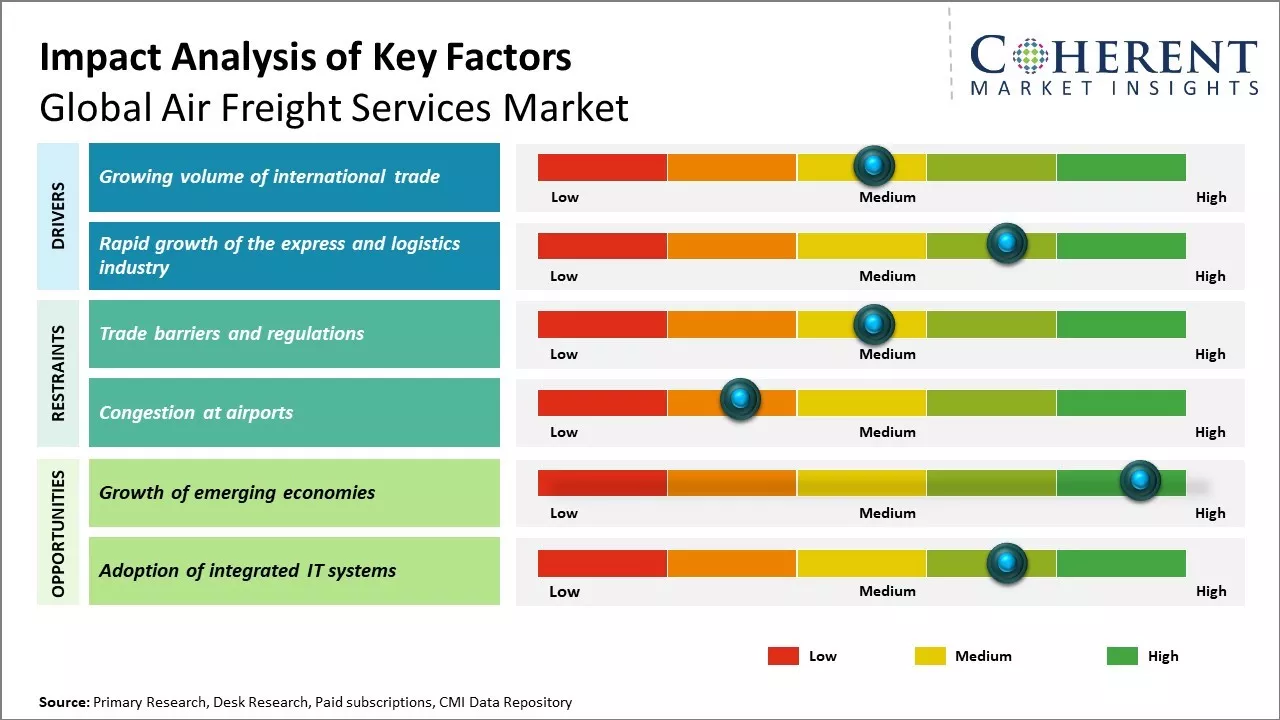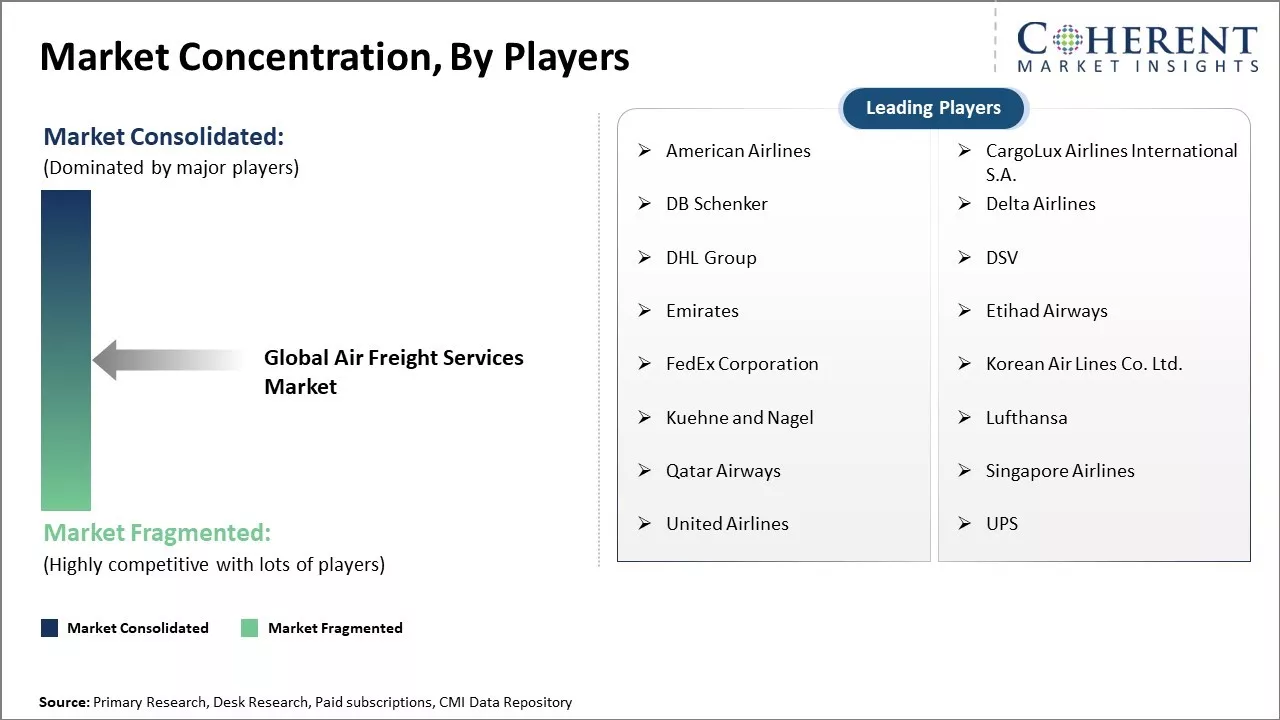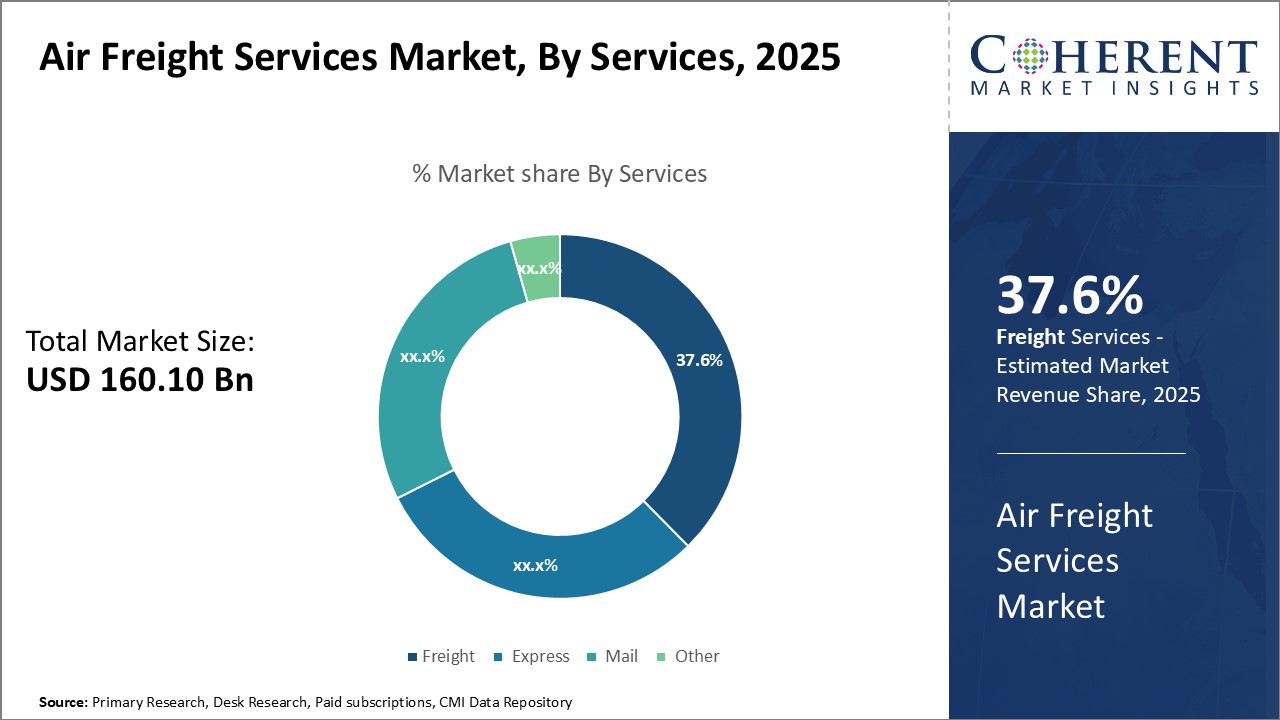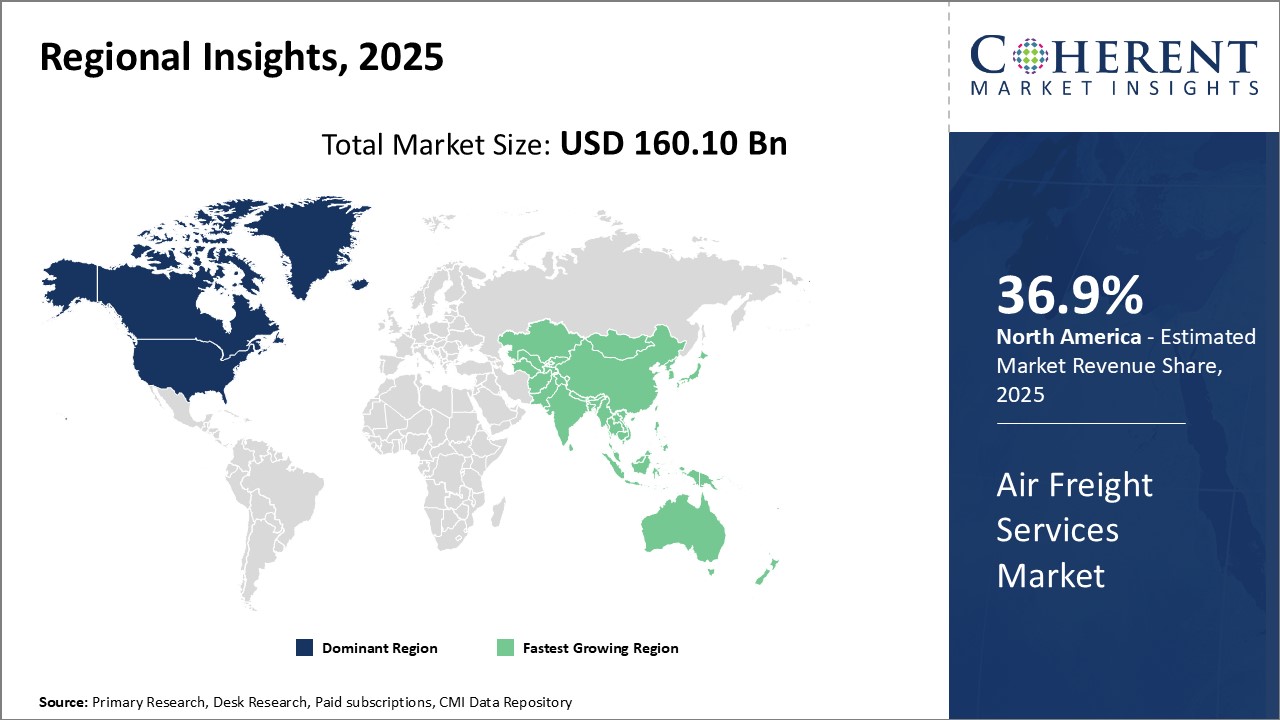Air Freight Services Market Size and Trends
The global air freight services market is estimated to be valued at US$ 160.10 Bn in 2025 and is expected to reach US$ 240.88 Bn by 2032, exhibiting a compound annual growth rate (CAGR) of 6.0% from 2025 to 2032.

Discover market dynamics shaping the industry: Download Free Sample
The market is expected to witness positive growth over the forecast period. There is an increase in overseas manufacturing and international trade which is driving the growth of air freight services. Many companies are increasingly adopting air freight to transport time-sensitive cargo such as perishable items and high-value goods. Adoption of digital technologies by major players is helping improve supply chain efficiency and attract more customers. However, issues related to high operating costs and global economic uncertainties remain challenges to market players. Still, initiatives to expand services through strategic partnerships and improve infrastructure will provide new opportunities for growth in the coming years.
Growing volume of international trade
The rise in globalization and liberalization of trade policies across the world has greatly facilitated the growth of international trade in recent decades. With nations increasingly specializing in the production of goods that they have a comparative advantage in and trading with other countries, the total volume of goods being traded globally has grown substantially year on year. Air cargo transport plays a vital role in facilitating this booming trade in goods between various economies located around the world. As the manufacturing capacities of developing nations continue to ramp up to meet the demands of both domestic as well as global markets, there has been a steady rise in the exports of these nations. Time-sensitive commodities, consumer electronics, pharmaceuticals, machinery parts, etc. are some major categories of goods being transported internationally in huge volumes daily using air freight services. Major exporting nations like China, Germany, South Korea, etc. have massive manufacturing bases generating enormous freight every year that use air cargo to reach overseas markets quickly.
Furthermore, the expansion of e-commerce and online retail has opened up new opportunities for international trade. Many online retailers now ship goods directly to customers located in other countries, relying majorly on air freight services to transport smaller consignments like clothes, accessories, electronics, etc. in a cost effective yet timely manner. This has further augmented the volumes being handled by air freight operators. As developing economies progress and their consumer markets evolve considerably, both domestic as well as international e-commerce activities are expected to witness strong growth trajectories well into the future. Besides finished consumer products, air transport remains the mode of choice for shipping raw materials and components required for manufacturing across borders. The ever-growing appetite of different industries for just-in-time delivery of inputs ensures continued growth in air freight volumes driven by trade.
Market Concentration and Competitive Landscape

Get actionable strategies to beat competition: Download Free Sample
Rapid growth of the express and logistics industry
The express and logistics industry has matured considerably in the past couple of decades following the adoption of advanced technologies and integration of various modes of transport. Major global players in the industry have built expansive networks and infrastructure to offer time-definite delivery of shipments across broad coverage areas. By consolidating smaller consignments and ensuring swift transfers between trucks, trains, vessels and aircraft, the industry has made international trade more accessible for businesses of all sizes. The high reliability, flexibility of services as well as real-time tracking offered by express companies have popularized the concept of door-to-door international freight shipping.
For instance, in February 2024, A.P. Moller - Maersk (Maersk) introduced a fully digital solution for customers seeking air freight services as part of its integrated logistics offerings. The new online platform, accessible through Maersk.com, empowers customers to easily book their air cargo requirements using a simple online tool that provides instant pricing for up to 70,000 connections between virtually all relevant airports worldwide.
Key Takeaways from Analyst:
The global air freight services market faces growth opportunities in the coming years, especially as international trade expansion continues. Several factors are positively influencing the demand for air cargo transportation worldwide. Rapid growth of e-commerce is a major driver, as more goods need to be shipped quickly across borders to satisfy online customers. Many industries rely on just-in-time manufacturing and delivery methods as well, necessitating speedy air freight options. Additionally, healthcare and pharmaceutical companies frequently use air cargo to transport temperature-sensitive drugs, vaccines, and medical equipment safely.
However, sharply fluctuating fuel costs pose a restraint if prices rise substantially. Any economic slowdowns that weaken global trade could also negatively impact market development. Geopolitical tensions exacerbating custom restrictions represent risks to maintain smooth air cargo flows. Competition from more economical ocean freight alternatives also applies competitive pressure, especially for bulky, non-urgent shipments.
Among regions, North America currently leads in terms of air cargo traffic and will likely maintain dominance. Strong trade links between China, other Asian nations, Europe, and North America fuel significant demand. Asia Pacific is another major center of activity given its developed markets. European carriers also benefit from high volume intra-regional trade.
Market Challenges: Trade barriers and regulations
Stringent regulations surrounding aviation and international trade have made it quite difficult for air freight carriers to efficiently transport goods across borders. Many countries have implemented protectionist policies through high import tariffs and strict customs procedures to promote their local industries. This often leads to delays in the clearance for air cargo and increased transaction costs for international shipping.
Market Opportunities: Growth of emerging economies
Many developing nations across Asia Pacific, Africa, and Latin America are witnessing substantial increases in manufacturing and industrial capabilities as their populations become more affluent. This rising production and consumption in emerging markets is driving significant demand for reliable transport of parts, components, and finished goods globally through air cargo. Thus, with manufacturing and consumer bases broadening collectively, emerging economies are primed to drive significant increments in demand for time-critical freight delivery globally. By capitalizing on these trends through fleet expansion, route development, and free trade agreements with developing nations, air freight services providers can maximize growth prospects in the long run. This potential offered by increasingly affluent emerging markets makes for a very encouraging outlook.

Discover high revenue pocket segments and roadmap to it: Download Free Sample
Insights By Services - Dependent Relationships Drive Freight Forwarding Volume
In terms of services, freight contributes the 37.6% share of the market in 2025 owing to the critical roles it plays in facilitating international trade. Air freight forwarding of goods relies on complex supply chains that span the globe. Manufacturers depend on reliable transportation and logistics to deliver parts and products to factories located in different countries. Likewise, retailers depend on timely shipment of goods from overseas warehouses to stock store shelves. As international sourcing and outsourcing have become prevalent business strategies, the volume of air freight forwarding has steadily increased over the years.
Another important factor is the consolidation of shipping volumes through freight forwarders. Rather than individual companies handling their own international shipments piecemeal, there are significant cost savings and efficiency gains through freight consolidators aggregating cargo from multiple clients on the same vessels or flights. This hub-and-spoke model enables economies of scale that would not be feasible otherwise, further boosting freight forwarding activity. Time-definite logistics are also crucial forustries like electronics and pharmaceuticals where components have tight interdependencies or products have short shelf lives. Dependable freight services ensure just-in-time production cycles remain undisrupted.
Insights By Destination- Proximity Advantage Boosts Domestic Air Cargo
Looking at segmentation by destination, the domestic segment captures the 54.7% share due to geographic and logistical advantages over alternatives in 2025. For domestic routes within large countries like the U.S., China, or India, air transport offers unmatched speed when rapid replenishment of inventory or urgent delivery of parcels is required. While road and rail freight work well for bulk movement of goods over long distances, air freight is better suited for high-priority, time-critical domestic shipments. Similarly, remote or island communities separated by vast ocean stretches rely heavily on air transport to receive essential supplies.
Regional economic integration initiatives have also served to stimulate domestic air cargo. Preferential trade agreements lowering cross-border barriers have led to increased flow of materials and components between neighboring territories. This intra-regional trade complements longer-haul international shipping lanes. Proximity favors air transport overseas for such flows within economic unions like Southeast Asian Nations or European Union (EU) countries. Overall, the nearness factor tilts the balance heavily in favor of air cargo for domestic over land transport within larger geographical markets.
By End User - Outsourcing Non-Core Functions Boosts the Commercial Segment
Based on end user, commercial contributes the 64.3% share to overall air freight revenues in 2025. Modern enterprises increasingly focus on their core competencies and outsource all other non-essential functions. Transportation and logistics fall in the latter category for most businesses, and air freight forwarders provide a proven full-service solution. Commercial shippers leverage the specialized expertise of freight companies to efficiently coordinate pick-ups, customs clearance, warehousing and deliveries globally. This lets corporate customers concentrate on growing their main revenue-generating business operations while reliable partners handle shipping needs.
Outsourcing logistics also provides flexibility and scalability advantages. Commercial capacity can be temporarily scaled up or down through flexible contract rates with freight forwarders based on the fluctuating volume levels throughout the year. This avoids having to maintain expensive fixed infrastructure that may lie underutilized during certain periods. Risks of non-compliance with trade regulations or damaged/lost goods are also mostly eliminated by entrusting experienced freight handlers. All these factors make outsourcing logistics an appealing proposition for commercial organizations, driving their dominance in the end user segment.
Regional Insights

Need a Different Region or Segment? Download Free Sample
North America has been the dominant player in the global air freight services market with 36.9% share in 2025. The U.S., in particular, has one of the largest air cargo industries in the world. This can be attributed to several factors like the strong presence of American multinational airlines like FedEx and UPS who have built expansive global networks for transporting goods. American exports like electronics, medical equipment, and agriculture products are majorly transported through air freight globally. Besides, several major manufacturing hubs in the U.S. that produce high-value, time-sensitive parts rely heavily on-air freight services.
The aviation industry in the U.S. also benefits from policies and infrastructure supportive of a large air cargo industry. Key cargo airports like Memphis, Cincinnati and Louisville act as major cargo hubs. North American companies have also led innovations in the sector that have raised efficiency and automation levels at cargo terminals. However, rising fuel costs and increasing preference for ocean freight for heavy shipments may impact market leadership going forward.
Among emerging regions, Asia Pacific has emerged as the fastest growing market for air freight services in recent years. Rapid industrialization and globalization of manufacturing have propelled export-driven economies in East and Southeast Asia. Countries like China, South Korea, Japan, and Taiwan are now major exporters of electronics, machinery and automobile components which are primarily transported through air. Southeast Asian nations like Malaysia, Thailand, and Vietnam have also emerged as manufacturing and export powerhouses catering to global supply chains.
This rise of Asia Pacific as the global factory has directly benefited the air freight sector. Major Asian airports like Hong Kong, Incheon, and Guangzhou have developed advanced logistics capabilities to handle time-sensitive cargo volumes. Carriers like Cathay Pacific and China Airlines have also strengthened their regional and intercontinental networks. With increasing disposable incomes, Asia Pacific's fast growing e-commerce sector is also driving immense growth opportunities for fast-moving cargo shipments. Going forward, sustained growth of Asian exports and regional trade will ensure the region leads air freight industry expansion globally.
Market Report Scope
Air Freight Services Market Report Coverage
| Report Coverage | Details | ||
|---|---|---|---|
| Base Year: | 2024 | Market Size in 2025: | USD 160.10 Bn |
| Historical Data for: | 2020 To 2024 | Forecast Period: | 2025 To 2032 |
| Forecast Period 2025 to 2032 CAGR: | 6.0% | 2032 Value Projection: | USD 240.88 Bn |
| Geographies covered: |
|
||
| Segments covered: |
|
||
| Companies covered: |
American Airlines, CargoLux Airlines International S.A., DB Schenker, Delta Airlines, DHL Group, DSV, Emirates, Etihad Airways, FedEx Corporation, Korean Air Lines Co. Ltd., Kuehne and Nagel, Lufthansa, Qatar Airways, Singapore Airlines, United Airlines, and UPS |
||
| Growth Drivers: |
|
||
| Restraints & Challenges: |
|
||
Uncover macros and micros vetted on 75+ parameters: Get instant access to report
Air Freight Services Industry News
- In March 2024, Challenge Group, an international air cargo conglomerate, announced the launch of a new scheduled freighter service connecting Mumbai (BOM) and Liège (LGG). The route will operate twice weekly, utilizing the capacity of Challenge Group's recently acquired second B767 freighter, which has a payload of 52 tons per flight.
- In February 2024, AllMasters, a digital freight consolidation platform focusing on Less Than Container Load (LCL) exports, introduced its recent solution planned to tackle the challenges faced by freight forwarders in the industry
- In February 2024, Etihad Cargo, the cargo and logistics arm of Etihad Aviation Group, announced a strategic partnership with Worldwide Flight Services (WFS), a member of the SATS Group, to provide cargo handling services at 12 major international airports across Europe, Scandinavia, North America, India, and the Asia Pacific region.
*Definition: The global air freight services market consists of companies that provide freight transport and logistics services via air transportation on international routes. This includes arranging for the pick-up, transport and customs clearance of shipments and goods via commercial passenger and cargo jets between origins and destinations in different countries worldwide. Air freight services play a crucial role in the mobility of time-sensitive cargo and ensuring just-in-time delivery of goods in global trade.
Market Segmentation
- Services Insights (Revenue, US$ Bn, 2020 - 2032)
- Freight
- Express
- Other
- Destination Insights (Revenue, US$ Bn, 2020 - 2032)
- Domestic
- International
- End User Insights (Revenue, US$ Bn, 2020 - 2032)
- Private
- Commercial
- Regional Insights (Revenue, US$ Bn, 2020 - 2032)
- North America
- U.S.
- Canada
- Latin America
- Brazil
- Argentina
- Mexico
- Rest of Latin America
- Europe
- Germany
- U.K.
- Spain
- France
- Italy
- Russia
- Rest of Europe
- Asia Pacific
- China
- India
- Japan
- Australia
- South Korea
- ASEAN
- Rest of Asia Pacific
- Middle East & Africa
- GCC Countries
- Israel
- South Africa
- Rest of Middle East & Africa
- North America
- Key Players Insights
- American Airlines
- CargoLux Airlines International S.A.
- DB Schenker
- Delta Airlines
- DHL Group
- DSV
- Emirates
- Etihad Airways
- FedEx Corporation
- Korean Air Lines Co. Ltd.
- Kuehne and Nagel
- Lufthansa
- Qatar Airways
- Singapore Airlines
- United Airlines
- UPS
Share
Share
About Author
Suraj Bhanudas Jagtap is a seasoned Senior Management Consultant with over 7 years of experience. He has served Fortune 500 companies and startups, helping clients with cross broader expansion and market entry access strategies. He has played significant role in offering strategic viewpoints and actionable insights for various client’s projects including demand analysis, and competitive analysis, identifying right channel partner among others.
Missing comfort of reading report in your local language? Find your preferred language :
Transform your Strategy with Exclusive Trending Reports :
Frequently Asked Questions
EXISTING CLIENTELE
Joining thousands of companies around the world committed to making the Excellent Business Solutions.
View All Our Clients
